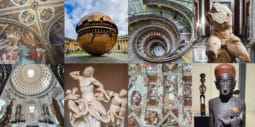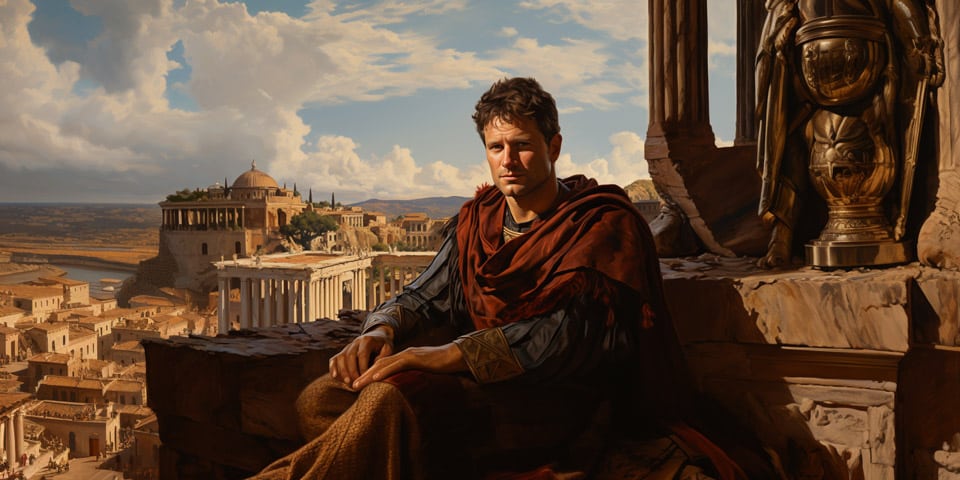

989429 travellers read

Caesar Augustus (27 BCE – 14 CE) was the first emperor of the Roman Empire. He was born with the name Gaius Octavius Thurinus on 23 September 63 BCE and adopted by his great-uncle Julius Caesar in 44 BCE. Consequently, he took the name Gaius Julius Caesar. Later on, in 27 BCE, the Senate proclaimed him the honorific Augustus, which means “the illustrious one”, so he became known as Gaius Julius Caesar Augustus.
Despite having many names, he is commonly referred to as Octavius during the period from 63 to 44 BCE, Octavian between 44 and 27 BCE, and Augustus from 27 BCE until his death in 14 CE.
Contents
ToggleEmperor Augustus, the founding Roman Emperor, remains an iconic historical figure. From his early days as Octavian to his lasting impact as the architect of the Pax Romana, his life and legacy continue to fascinate. This section addresses popular questions about his leadership, political strategies, and personal life. Test your knowledge about Emperor Augustus as we explore the intricacies that made him a transformative leader and a subject of enduring curiosity.
After the assassination of Augustus’ stepfather, Julius Caesar, in March 44 BCE, the future emperor formed an alliance with Caesar’s close friend and relative, Mark Antony. Another supporter of Caesar, Marcus Aemilius Lepidus, also joined them, leading to the formation of the Second Triumvirate in October 43 BCE.
The first objective of this new alliance was to eliminate all political rivals and supporters of Caesar’s assassins. It remains unclear who bore the most responsibility for the killings; some historians regard Augustus as innocent, while others consider him the most ruthless. Once this goal was achieved, the Triumvirate turned its attention to Caesar’s assassins. At the Battle of Philippi in 42 BCE, the armies of Brutus and Cassius were defeated by the Triumvirate, forcing both to commit suicide.
Octavian and Lepidus attacked Sextus Pompeius (son of Pompey, Caesar’s main rival) for control of Rome, with Antony’s support from Egypt.
The Second Triumvirate ultimately triumphed over Pompeius. Lepidus then urged Octavian to leave Sicily—the main theatre of operations—with his army. However, Octavian offered large sums of money to Lepidus’ troops, prompting them to defect. As a result, Lepidus lost all his titles except Pontifex Maximus, marking the end of the Second Triumvirate.
Following the dissolution of the Second Triumvirate, relations between Octavian and Mark Antony deteriorated sharply. In 40 BCE, Octavian sought to preserve their alliance by offering his sister, Octavia Minor, in marriage to Antony. However, Antony developed a strong bond with Cleopatra VII of Egypt—former lover of Caesar and mother of his son Caesarion—and eventually became her lover.
This romance triggered conflict between Octavian and Antony, with Octavian accusing him of dishonouring his sister. As a result, Octavia and Antony divorced.
Octavian began to regard Antony as an unfit leader—politically, privately, and militarily.
Caesar’s adopted son compelled the priestesses of the Temple of Vesta to surrender Antony’s will, which he then read aloud in the Senate. The will revealed that Antony intended to pass Roman territories to his children and have a grand mausoleum built in Alexandria for himself and Cleopatra.
Octavian denounced his former ally as a traitor. The most damning declaration from Antony was that Caesarion was Julius Caesar’s rightful heir. The Senate rejected Antony’s consulship and declared war on Cleopatra VII. At the Battle of Actium in 31 BCE, Octavian’s forces, led by General Agrippa, defeated the fleets of Antony and Cleopatra and pursued them to Alexandria. By 30 BCE, Antony and Cleopatra had taken their own lives. Moreover, Octavian had Caesarion strangled, stating, “two Caesars are one too many,” and also ordered the death of Antony’s eldest son, whom he saw as a threat to Rome.
These events paved the way for Octavian’s absolute leadership over Rome.
Determined to avoid the fate of his adoptive father, Octavian swiftly set out his political vision to the Roman people, presenting himself as a restorer of order. In 27 BCE, Octavian formally renounced his powers, confident they would be returned by the Senate, which also bestowed upon him the title “Augustus.” He preferred to refer to himself publicly as “Princeps” or “First Citizen.” With the trust of the populace, Augustus succeeded in establishing complete control over Rome and its territories.
Already known as Augustus, the month of August was named in honour of the first Emperor. In 19 BCE, Augustus received supreme authority over all the provinces of the Roman Empire and began to rule with absolute power.
By 2 BCE, Augustus was proclaimed Pater Patriae – the Father of the Country.
Undeniably, his reign marked a prosperous period for the Empire, as he promoted peace among citizens and revitalised the economy, arts, and agriculture. During Augustus’ leadership, numerous new buildings were erected. He not only implemented plans initiated by Caesar but also introduced many of his own. For example, he restored 82 buildings in a single year, including Rome’s public baths, alongside his chief ally, Agrippa. Augustus was also a patron of the arts and inspired many poets, such as Virgil, who composed the Aeneid. Numerous reforms and laws were introduced under Augustus’ rule. A key focus was on encouraging stable marriages and increasing the birth rate. As such, penalties were imposed on childless unions, and families with more than three children received tax reductions.
Augustus died in 14 CE. His final words became legendary: “I found Rome a city of clay but left it a city of marble.” However, according to his wife Livia and his adopted son Tiberius—who succeeded him as the second emperor of Rome—his last words were: “Have I played the part well? They applaud as I exit.” The emperor’s body was buried in Rome.
During his reign, the emperor expanded the Roman Forum, and today you can visit the remains of the Forum of Augustus in central Rome.
Emperor Augustus, the founder of the Roman Empire, has been immortalised in numerous statues that have survived to the present day.
Interestingly, these statues consistently portray him as youthful and vigorous, projecting an image of eternal vitality. This contrasts with the fact that he lived to the age of 75.
Thanks to modern computer and AI technology, we now have lifelike reconstructions of Emperor Augustus. These representations offer a rare chance to visualise the face of one of history’s most influential figures—albeit through the lens of classical artistic interpretation.
If you’re interested in Roman architecture, Augustus’ legacy is essential knowledge. As the first emperor, he transformed Rome into a showcase of imperial grandeur. Here are some of the most iconic structures from his reign:
The Ara Pacis is far more than an altar—it’s a masterpiece of Roman sculpture. Dedicated to Pax, the Roman goddess of peace, it was inaugurated on Livia’s birthday. The detailed friezes resemble a carved narrative celebrating the Pax Romana.
Augustus felt that the original Roman Forum had become overcrowded, so he commissioned the Forum of Augustus. This new forum included the Temple of Mars Ultor—Mars the Avenger—in honour of Augustus’ victory at Philippi.
More than a family tomb, the Mausoleum of Augustus was a symbol of dynastic ambition. Constructed with concentric rings and crowned with cypress trees, it contained golden urns holding the ashes of Augustus and his family.
Named in memory of his nephew Marcellus, who died young, this theatre became a prominent venue for public performances. Its design later inspired the Colosseum. With a capacity of 20,000, it reflected the Roman fondness for social hierarchy, with seating arranged by class. Learn more about the Theatre of Marcellus.
Imagine a colossal sundial that also functioned as a calendar—that’s the Solarium Augusti. At its centre stood an Egyptian obelisk brought from Heliopolis, acting as the sundial’s gnomon (pointer). It was a remarkable feat of engineering and symbolism, combining timekeeping with imperial prestige.
Named after Augustus’ sister Octavia, this structure was far more than a simple renovation. It became a vibrant cultural centre housing libraries, lecture halls, and impressive artwork. Notably, it’s even referenced in Shakespeare’s The Merchant of Venice, cementing its place in both Roman and literary history.
Originally begun by Julius Caesar, this temple was completed by Augustus in honour of his adoptive father. It was the first Roman temple dedicated to a deified leader. Romans would visit to make offerings to Caesar’s spirit, and it featured the famous altar marking the “Ides of March”.
Looking for fresh water? This aqueduct was a revolution in public health, designed to bring clean water into Rome. Remarkably, the Aqua Virgo is one of the few ancient aqueducts still in use today—proof of Roman engineering at its finest.
There you have it! Next time you’re strolling through Rome, these insights will add historical depth to your sightseeing and might even impress your travel companions.
Heading to Rome? Dive into the fascinating world of Emperor Augustus, a monumental figure in Roman history. These intriguing facts will enhance your visit and give you a deeper appreciation of the man who helped shape an empire.
Author: Artur Jakucewicz
This website uses cookies. For more info read the cookies policy
RomeItaly.guide © 2025. Created with love by Roman experts and guides.